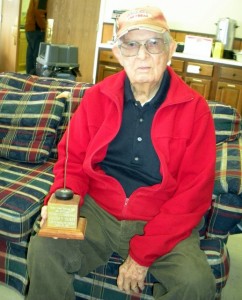Have you noticed the small windsock trophy with a kink in the windsock pole? It normally resides on the mantle. There is a second similar trophy that gets blown around the clubhouse as well. Jim Hurst took so much heckling about an incident that took place while he was flying the tow plane that he wrote an article for the Frequent Flyer that was published in December 1991. Since then the wind sock has been relocated at least twice, so for this story you should visualize it on the northeast corner of the runway just where pedestrians stand to wait for a landing tow plane. Here is the story:
There has been no little curiosity as to how the pole holding the northeast windsock got the weird wrinkle in it. To make a long story short, I wrapped a tow rope around it on October 30 [1991] while on final, disassembling the whole thing. The windsock was mounted on a tall pipe which was set on a smaller diameter pipe, which was embedded in concrete. The tall pipe was pulled off the short pipe and flung down the runway and both pipes were pretty severely bent in the process. Nobody actually saw it, but they described the sound as “Buwaaaang” or “Sprewooing” or some such, apparently the sound of pipe sliding out of pipe. The strange kinks in the pipes resulted when we reassembled them, and tried to straighten them without the benefit of sophisticated tools. We used the van, a log chain, the tractor and a gang of bare hands. The pipes refused to unbend in the same place they were bent. The pipe is now more or less back to vertical, but a little wavy!

Aside from the comic aspects of the damage and repair of the sock, there are certain lessons to be learned. I claimed that my ground track was definitely over the runway and that the strong crosswind from the south blew the tow rope over the fence line. Further analysis indicates that this could be so. We probably had a crosswind component from the south of about 10 mph. I was trying to minimize the effects by flying diagonally across the runway, say on a course of 265 degrees. My little E6B shows that with a wind of 10 mph from 180, to maintain a ground track of 265 degrees with an airspeed of 60 mph I would have had to crab about 9 degrees into the wind. The rope would stream back in line with the longitudinal axis of the airplane. Since the airplane and its rope are about 250 feet long, the ground track of the ring on the end would be 39 feet north of the ground track of the airplane (sin 9 deg. x 250′ = 39′). This means the towplane can be well clear of the fence line (and the wind sock) crossing the road, but the end of the rope would be 39 feet farther north.
Obviously, with strong crosswinds, we need to realize that the track of the end of the rope is considerably downwind from the track of the airplane, and provide clearance accordingly. Those on the ground need to be aware of the same thing. The whole problem is solved if we have plenty of altitude crossing the road. I’m as guilty as anybody of breaking this rule because I just have trouble getting out of the habit of wanting to touch down on the near end of the runway. No need to do that. We have plenty of room to land in the middle. – Jim Hurst